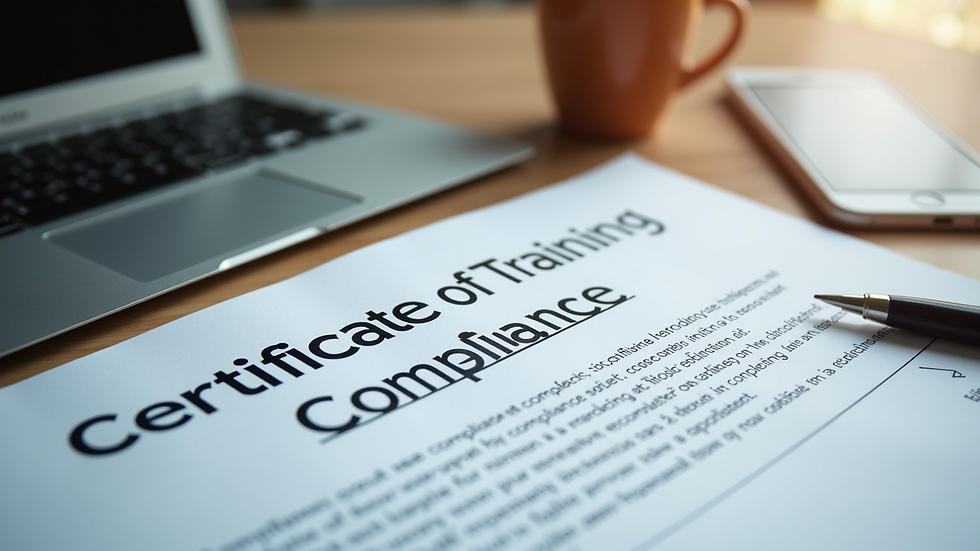How to Choose Effective Compliance Training Courses
- Lora R
- 6 days ago
- 4 min read
Choosing the right compliance training courses is essential for any organization aiming to maintain legal standards and promote a safe, ethical workplace. With numerous options available, it can be challenging to identify which courses will truly benefit your team and meet regulatory requirements. This guide will help you navigate the selection process by highlighting key factors to consider, practical tips, and the importance of effective training.
Understanding the Importance of Effective Compliance Training
Effective compliance training is more than just a checkbox for regulatory bodies. It plays a crucial role in preventing violations, reducing risks, and fostering a culture of integrity. When employees understand the rules and the reasons behind them, they are more likely to follow policies and report issues proactively.
To ensure training is effective, it should be:
Relevant to the specific industry and job roles.
Engaging to keep learners interested and motivated.
Up-to-date with current laws and regulations.
Accessible to all employees, including remote or part-time workers.
For example, a healthcare organization might focus on patient privacy laws like HIPAA, while a manufacturing company would emphasize workplace safety standards. Tailoring content to your industry ensures employees receive practical knowledge they can apply daily.

Key Features of Effective Compliance Training
When evaluating compliance training courses, look for features that enhance learning and retention. Here are some critical elements to consider:
1. Interactive Content
Courses that include quizzes, case studies, and real-life scenarios help learners apply concepts rather than just memorize rules. Interactive content encourages active participation, which improves understanding and recall.
2. Clear Learning Objectives
Each module should have specific goals, so employees know what skills or knowledge they will gain. Clear objectives also help trainers measure the effectiveness of the course.
3. Flexibility and Accessibility
Training should be available on multiple devices and at convenient times. This flexibility allows employees to complete courses without disrupting their work schedules.
4. Expert Instruction and Credibility
Choose courses developed or endorsed by industry experts or regulatory bodies. This ensures the material is accurate and trustworthy.
5. Tracking and Reporting
A good compliance training program includes tools to track progress and completion rates. This feature helps managers ensure all employees meet training requirements and identify areas needing improvement.
By focusing on these features, you can select courses that not only fulfill legal obligations but also empower your workforce.

Is a Compliance Certificate Worth It?
Many compliance training courses offer certificates upon completion. But is earning a compliance certificate truly valuable?
The answer depends on your organization's goals and industry standards. Here are some benefits of obtaining a compliance certificate:
Proof of Training: Certificates serve as documented evidence that employees have completed required training, which can be crucial during audits or legal reviews.
Motivation: Certificates can motivate employees to complete courses and take training seriously.
Professional Development: For individuals, certificates can enhance resumes and demonstrate commitment to ethical practices.
However, a certificate alone does not guarantee that employees have internalized the training or will apply it effectively. The real value lies in the quality of the course and how well it prepares employees to handle compliance issues.
To maximize benefits, combine certification with ongoing training, assessments, and real-world application.

How to Evaluate and Select the Right Compliance Training Courses
Selecting the right compliance training courses requires a systematic approach. Follow these steps to make an informed decision:
Step 1: Assess Your Compliance Needs
Identify the specific regulations and standards your organization must follow. Consult legal advisors or compliance officers to understand mandatory training requirements.
Step 2: Define Training Objectives
Determine what you want employees to learn and achieve. Objectives might include understanding legal obligations, recognizing risks, or improving reporting procedures.
Step 3: Research Available Courses
Look for courses that match your needs. Consider factors such as:
Course content relevance
Delivery method (online, in-person, hybrid)
Duration and flexibility
Cost and licensing options
Step 4: Review Course Quality
Request demos or trial access to evaluate course design, interactivity, and instructor expertise. Read reviews and testimonials from other organizations.
Step 5: Check for Certification and Compliance
Ensure the course provides valid certification and aligns with industry standards or regulatory requirements.
Step 6: Plan for Implementation and Follow-up
Decide how you will roll out the training, monitor progress, and reinforce learning through refresher courses or assessments.
By following these steps, you can confidently choose courses that meet your organization's compliance goals.
Leveraging Compliance Training Courses for Maximum Impact
Integrating the right compliance training courses into your organizational strategy can significantly reduce risks and improve workplace culture. Here are some actionable recommendations:
Customize Training: Adapt courses to reflect your company’s policies and real-world scenarios employees face.
Encourage Engagement: Use incentives, gamification, or group discussions to keep learners motivated.
Measure Effectiveness: Use quizzes, surveys, and performance metrics to assess knowledge retention and behavior change.
Provide Ongoing Support: Compliance is an evolving field. Offer refresher courses and updates to keep employees informed.
Promote a Culture of Compliance: Leadership should model ethical behavior and emphasize the importance of compliance training.
By investing in quality training and fostering a supportive environment, organizations can turn compliance from a burden into a competitive advantage.
Choosing effective compliance training courses is a strategic decision that impacts your organization's legal standing and workplace safety. By understanding your needs, evaluating course features, and implementing training thoughtfully, you can build a knowledgeable and compliant workforce ready to meet today's challenges.




Comments